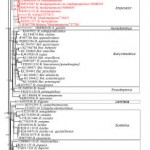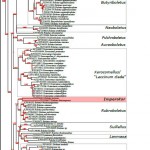Phylogenetics
 Phylogenetic reconstruction of Boletaceae based on ITS rDNA sequences by Maximum Likelihood analysis.
Phylogenetic reconstruction of Boletaceae based on ITS rDNA sequences by Maximum Likelihood analysis.
(click on the photo for a full-resolution PDF)
Reference sequences (focusing on European species) were downloaded from the public databases GenBank (http://www.ncbi.nlm.nih.gov/genbank) and UNITe (unite.ut.ee, codes starting by UDB…).
Analyses were conducted online at www.phylogeny.lirmm.fr (Dereeper et al. 2008, Nuc Acids Res 36:W465–469, doi:10.1093/nar/gkn180), using the GTR + I + C model of evolution. Multiple sequence alignment was carried out online with MUSCLE 3.7 (Edgar 2004, BioMed Cen Bioinform 5:113, doi:10.1186/1471-2105-5-113) at www.phylogeny.lirmm.fr using full processing mode and 16 iterations. Sequences of Chalciporus piperatus, C. rubinus and Buchwaldoboletus lignicola were selected as outgroups following Nuhn et al. (2013, Fungal Biol. 117: 479-511, as “Chalciporus-group”). Sequences of Leccinum ss.str. were discarded from the initial dataset due to difficulties of alignments of ITS1 and ITS2 regions.
 Phylogenetic reconstruction of Boletaceae based on 28S (LSU) rDNA sequences by Maximum Likelihood analysis.
Phylogenetic reconstruction of Boletaceae based on 28S (LSU) rDNA sequences by Maximum Likelihood analysis.
(click on the photo for a full-resolution PDF)
Reference sequences were downloaded from the public database GenBank (http://www.ncbi.nlm.nih.gov/genbank).
Analyses were conducted online at www.phylogeny.lirmm.fr (Dereeper et al. 2008, Nuc Acids Res 36:W465–469, doi:10.1093/nar/gkn180), using the GTR + I + C model of evolution. Multiple sequence alignment was carried out online with MUSCLE 3.7 (Edgar 2004, BioMed Cen Bioinform 5:113, doi:10.1186/1471-2105-5-113) at www.phylogeny.lirmm.fr using full processing mode and 16 iterations. Sequences of Chalciporus spp. and Buchwaldoboletus lignicola were selected as outgroups following Nuhn et al. (2013, Fungal Biol. 117: 479-511, as “Chalciporus-group”).